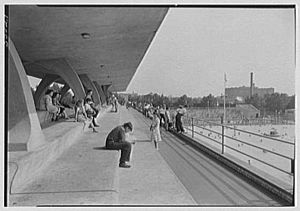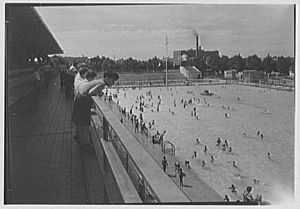Betsy Head Park facts for kids
Quick facts for kids Betsy Head Park |
|
|---|---|

Exterior of the Betsy Head Play Center
|
|
| Location | Brownsville, Brooklyn, New York |
| Area | 10.55 acres (4.27 ha) |
| Created | 1915 |
| Operated by | New York City Department of Parks and Recreation |
| Open | 6 a.m. to 1 a.m. |
| Status | open |
Betsy Head Park is a large public park in Brownsville, Brooklyn, New York City. It covers about 10.5 acres and is split into two parts. The park has a playground, sports fields, a bathhouse, and a swimming pool. The bathhouse and pool are known as the Betsy Head Play Center. This center is a special landmark, protected by the New York City Landmarks Preservation Commission. The New York City Department of Parks and Recreation (NYC Parks) manages the park.
The park first opened in 1915 with a bathhouse and pool. The current pool and bathhouse were built between 1935 and 1936. They were part of a big project by the Works Progress Administration (WPA), which helped people find jobs during the Great Depression. The buildings were designed in the Art Moderne style. After a fire in 1937, the bathhouse was rebuilt. The park's facilities have been updated several times, including in the early 1980s and again in the late 2010s.
Contents
What Sports Can You Play at Betsy Head Park?
Betsy Head Park is divided into two sections. These sections are across the street from each other at Dumont Avenue and Thomas S. Boyland Street. The park offers many sports facilities for everyone to enjoy.
- Baseball and Football: There are three baseball fields and two football fields. Some of these fields overlap, so you can't use them for both sports at the same time.
- Tennis: You'll find eight tennis courts.
- Basketball: There are six basketball courts.
The larger part of the park is on the southwest side of Dumont Avenue and Thomas S. Boyland Street. It has two baseball fields, one football field, four tennis courts, and one basketball court. The smaller part of the park is on the northeast side. It has another baseball field, a football field, and more basketball and tennis courts. Years ago, this smaller section even had a small farm where schoolchildren could learn to grow things!
Discover the Betsy Head Play Center
The Betsy Head Play Center is a key part of the park. It includes the swimming pool and the bathhouse.
How the Original Park Looked
When Betsy Head Park first opened, it was designed to be very modern. The larger part of the park had a big stadium with a running track. There was also a two-story building called a field house. This building had restrooms, club-rooms, and lockers. It also had gyms for men and women, with space for sports like basketball and handball.
The eastern part of the park's larger section had a swimming pool and a bathhouse. The original pool was quite big, about 150 feet long and 60 feet wide. The bathhouse was designed to serve many people, up to 4,000 visitors each day.
The Modern Look: Art Moderne Design
The current bathhouse was built in the Art Moderne style. This style was popular in the 1930s and looks very sleek and modern. The architect, Ely Jacques Kahn, said the building was made "for enjoyable use." Even Robert Moses, a famous parks commissioner, thought the plans were excellent.
Unlike some other city pools, Betsy Head Play Center never had a separate wading pool for very young children. It had a main swimming pool and a diving pool. The diving pool was later filled in.
Inside the Bathhouse
The bathhouse is in the southwestern part of the park. Its main entrance faces Thomas S. Boyland Street. The outside walls are made mostly of glass bricks and regular bricks. This design lets in a lot of natural light. There's a main entrance with steps and a ramp for wheelchairs.
Inside, the lobby separates the men's and women's locker rooms. The lobby has a cool ceiling with stepped squares. A round brick column stands in the middle. There used to be a ticket booth, but now the pool and bathhouse are free to use! Signs above the doors use Art Deco-style letters to show where each room is.
The locker rooms have concrete floors and brick walls. They were designed so they could be turned into gyms in the winter. The shower rooms are at the end of the locker rooms and also have entrances from the pool area.
Above the building, there's a rooftop deck. This deck used to have a canopy and concrete bleachers for watching events in the pool. Today, the roof is closed to the public.
The Pool Area
The main pool is west of the bathhouse. It's a large rectangular pool, about 330 feet long and 165 feet wide, and about 4 feet deep. A concrete area surrounds the pool, and a fence goes around it. In the middle of the pool, there are two small islands. These islands have systems to keep the water clean. They used to have fountains!
The diving pool was next to the main pool. It was filled in around 2005-2006 and is now a volleyball court. There are also concrete bleachers on the south side of the pool area. These bleachers were built with the original bathhouse. Underneath them, you can see five round windows.
The Story of Betsy Head Park
How the Park Began
In the early 1900s, Brownsville was a very crowded neighborhood. Many people lived there, and there wasn't much open space. A local group suggested building a park. At that time, Brooklyn had very few playgrounds.
The park was made possible by a generous gift from a wealthy British woman named Betsy Head. When she died in 1907, she left a lot of money for New York City parks and charities. About $190,000 was set aside for parks. Some residents of Brownsville asked if this money could be used for a park in their neighborhood.
There was some debate because the land for the park would be paid for by a tax on nearby landowners. But in July 1913, the city approved the park. The land was bought, and Betsy Head's money paid for the park's facilities.
Plans for Betsy Head Park were finished in 1914. The park was designed to be "one of the finest in the world." It opened on September 30, 1915. It quickly became very popular and was often "overcrowded" because it was the only play area nearby. The park's design even won an award in 1915!
The WPA Renovation
In 1934, Robert Moses became the commissioner of NYC Parks. The United States was in the middle of the Great Depression, and many people were out of work. Moses started a big plan to create jobs by building and improving parks and facilities across the city.
He was especially interested in building new swimming pools. He planned 23 new pools, including one at Betsy Head Park. These pools were built with money from the Works Progress Administration (WPA), a government program that helped people find work. Eleven of these pools were designed to open around the same time in 1936.
Even though Betsy Head Park already had a pool, Moses thought it was old and needed to be completely redone. The new pool was much larger and included modern features like water filtration. The old field house was updated too, to hold more swimmers.
On August 7, 1936, Betsy Head Park's new pool area opened. It was one of the first new WPA pools to open in the city. Later, in September 1936, the main pool was drained for the winter and turned into a space for sports like basketball and volleyball.
Sadly, the original bathhouse was destroyed by a fire in August 1937. Moses quickly pushed for a new bathhouse to be built. The current one-story bathhouse opened on May 27, 1939.
In the mid-1900s, Brownsville became a mostly African American neighborhood. People of all backgrounds used Betsy Head Park's facilities without conflict. Famous boxer Riddick Bowe, who grew up in Brownsville, used to visit the park.
Park Improvements Over Time
By the 1970s, many city parks, including Betsy Head Park, were in poor condition. NYC Parks started a project to fix up pools in 1977. In 1979, about $5.2 million was set aside to restore Betsy Head Park. The park was rebuilt and reopened on June 28, 1983. The swimming and diving pools were redone, and the bathhouse was made accessible for people with disabilities.
Even after these renovations, the park faced challenges. In 1991, the mayor planned to close all outdoor pools in the city due to money problems. This decision was changed only after donations helped keep them open. To prevent people from getting in at night, a strong steel fence was added around the pool in 1993.
In 2008, the New York City Landmarks Preservation Commission officially named the Betsy Head Play Center a landmark. This was a big deal because it was the first individual landmark in Brownsville.
More recently, the playground inside the park was renovated in 2016. It now features an "Imagination Playground" with movable foam blocks, a fun and creative play area for kids. Later that year, $30 million was put aside for even more improvements to the park's sports facilities. Work on these updates began in 2019, making Betsy Head Park an even better place for the community.





